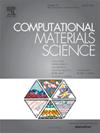全碳狄拉克材料α-石墨炔的带隙调制与型跃迁
IF 3.1
3区 材料科学
Q2 MATERIALS SCIENCE, MULTIDISCIPLINARY
引用次数: 0
摘要
α-石墨炔(α-GY)是一种全碳二维材料,由于其可预测的柔性性能,包括电子、光学、机械和场发射性能,引起了人们的极大兴趣。然而,零带隙限制了它的适用性。本文利用基于密度泛函理论的第一性原理计算,重点研究了以二硫化钼(MoS2)为衬底的α-GY的工程异质结构的电子性质。有趣的是,可以得到106.8 meV的带隙开口,这是由于电荷重分配引起的亚晶格对称破缺。此外,通过调整层间距离,可以成功地改变带隙。此外,随着层间距离的减小,带隙发生直接-间接跃迁。这说明不同的层间距离会引起不同的耦合效应,进而对异质结构的能带结构产生重要影响。我们的工作为实现α-GY的显著带隙提供了见解,并进一步使其成为电子器件中应用的有前途的候选者。本文章由计算机程序翻译,如有差异,请以英文原文为准。

Band gap modulation and type transition in all-carbon Dirac material α-graphyne by heterostructure engineering
α-graphyne (α-GY), an all-carbon two-dimensional material, has triggered enormous interest due to its predicted flexible properties, including electronic, optical, mechanical, and field emission properties. Nevertheless, the zero band gap imposes restrictions on its applicability. Here, utilizing the first-principles calculations based on density functional theory, we focus on the electronic properties of α-GY through engineering heterostructures with the substrate of molybdenum disulfide (MoS2). Interestingly, the band gap opening with 106.8 meV can be obtained, which is ascribed to the sublattice symmetry breaking brought by the charge redistribution. Furthermore, by adjusting the interlayer distance, the band gap can be successfully changed. Besides, a direct–indirect transition of the band gap occurs with the decreasing interlayer distance. It can be explained that the varying interlayer distances could induce different coupling effects, which in turn have an important impact on the band structure of the heterostructures. Our work provides insights into achieving a significant band gap of α-GY and further makes it a promising candidate for application in electronic devices.
求助全文
通过发布文献求助,成功后即可免费获取论文全文。
去求助
来源期刊

Computational Materials Science
工程技术-材料科学:综合
CiteScore
6.50
自引率
6.10%
发文量
665
审稿时长
26 days
期刊介绍:
The goal of Computational Materials Science is to report on results that provide new or unique insights into, or significantly expand our understanding of, the properties of materials or phenomena associated with their design, synthesis, processing, characterization, and utilization. To be relevant to the journal, the results should be applied or applicable to specific material systems that are discussed within the submission.
 求助内容:
求助内容: 应助结果提醒方式:
应助结果提醒方式:


